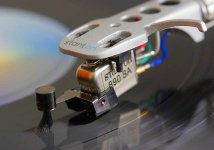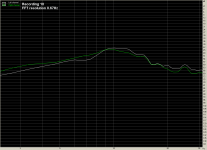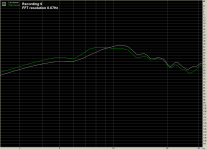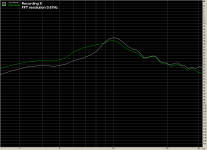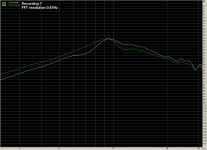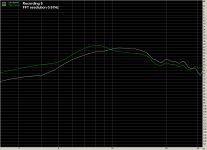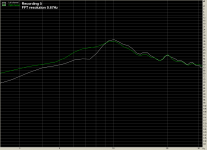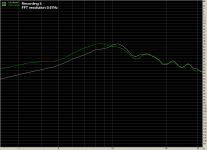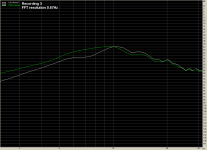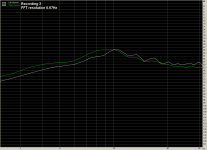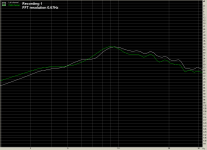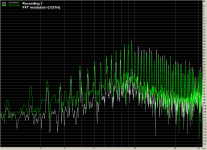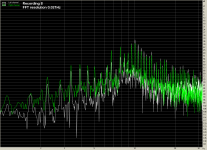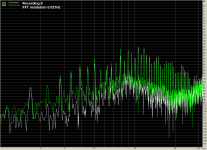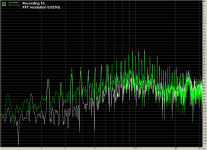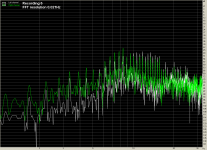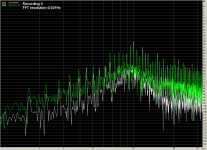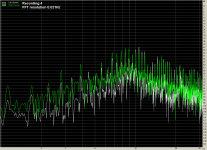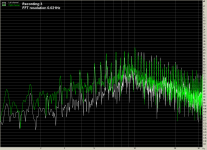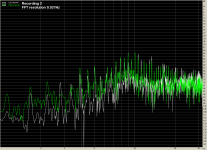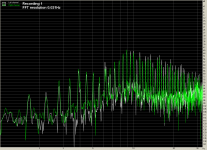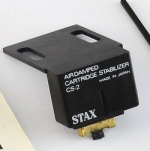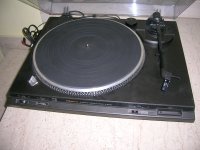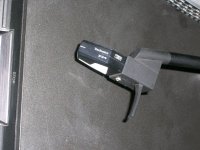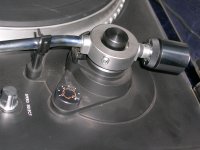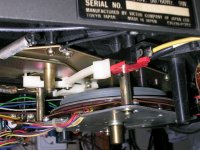Today's research was into how one might make a damped brush to go on any cartridge. If I understand correctly, in the Shure VST-V the damping was thick silione in the hinges. The stantons/pickerings OTOH seen to mount the CF brush in the damping gel.
Starting to scratch my head over how to replicate this without suitable tooling and came across the Jico stylus shown in the image. That looks like it would do the job nicely and should be able to be retrofitted onto a range of MM carts. Of course Would need to peruade Jico to sell them on their own.
Any other ideas how to try this on the cheap?
Starting to scratch my head over how to replicate this without suitable tooling and came across the Jico stylus shown in the image. That looks like it would do the job nicely and should be able to be retrofitted onto a range of MM carts. Of course Would need to peruade Jico to sell them on their own.
Any other ideas how to try this on the cheap?
Attachments
Today's research was into how one might make a damped brush to go on any cartridge. If I understand correctly, in the Shure VST-V the damping was thick silicone in the hinges.
That’s correct. See the very detailed US 4275888 patent (*).
Patent claims (claim #12) achieving damping vibrations occurring both vertically and perpendicularly to disk surface.
With my tests, I haven’t seen damping action for the lateral movement (due to record eccentricity). Perhaps it can be achieved with a brush of the kind detailed in patent US4514836
A very good read touching many aspects of interest is here:
High Fidelity Phonograph Cartridge - Technical Seminar | Shure Technical FAQ
George
(*) and go through referenced preceding patents to steal more ideas
Once again George you have come up trumps. Shure interestingly didn't see 0.5Hz eccentricity OR lateral resonance as a big issue and were focused entirely on warp in the techical seminar. And they get the same 9-10dB reductions as we have seen presented here.
Townsend claim nearly 18dB reductions with their damper. But those are marketing graphs so pinch of salt needed! Sure Max must have at some time shown some real numbers?
Townsend claim nearly 18dB reductions with their damper. But those are marketing graphs so pinch of salt needed! Sure Max must have at some time shown some real numbers?
Once again George you have come up trumps. Shure interestingly didn't see 0.5Hz eccentricity OR lateral resonance as a big issue and were focused entirely on warp in the techical seminar. And they get the same 9-10dB reductions as we have seen presented here.
Townsend claim nearly 18dB reductions with their damper. But those are marketing graphs so pinch of salt needed! Sure Max must have at some time shown some real numbers?
Townsend may achieve 18dB reduction with the oil bath compared to 9dB with the Shure brush, but this is not a simple case of 'more is better'. The Townsend method makes it harder for the cartridge to ride over a warp, the Shure brush makes it easier for the cartridge to ride over a warp.
The devil is in the details of how and where the damping is applied. It makes a BIG difference. See my post #15.
Ray K
Just to be clear, I don't consider warps a problem. I don't have any warped records and If I did I would consider flattening them again or investing in a clamp. I DO want to damp resonances in 2 planes.
As we would all have to pay to be able to discuss the AES paper in detail we can't delve into that at the moment, but the Shure papers George linked are actually anti pivot end damping. But Shure didn't make arms.
The other issue, which I am more interested in at the moment is how does the DIY'er with limited capabilities make ANY of these damping methods for testing.
(and note, if the AES paper is correct then the SME3009 S3 with VST-V really was the best there has ever been, which some have been telling us for years )
)
As we would all have to pay to be able to discuss the AES paper in detail we can't delve into that at the moment, but the Shure papers George linked are actually anti pivot end damping. But Shure didn't make arms.
The other issue, which I am more interested in at the moment is how does the DIY'er with limited capabilities make ANY of these damping methods for testing.
(and note, if the AES paper is correct then the SME3009 S3 with VST-V really was the best there has ever been, which some have been telling us for years
didn't see 0.5Hz eccentricity OR lateral resonance as a big issue
Bill, the record eccentricity has attracted my attention and it causes me some headaches
You may have noticed this from the FFTs of post # 39 and # 40 but I will show a series of FFTs for to illustrate the point.
First, ten FFTs of 40 seconds recordings with a resolution of 0.67Hz (44100Hz sampling, FFT size 65536 points)
George
Attachments
Last edited:
Now, FFTs of the same recordings, only with a resolution of 0.021Hz (44100Hz sampling, FFT size 4194304 points)
There are a few things to notice while comparing the low resolution FFTs with the high resolution FFTs .
Take your time watching them.
The secret is that all recordings were done on the same TT, with the same arm, cartridge, platter mat, RIAA pre ect.
is that all recordings were done on the same TT, with the same arm, cartridge, platter mat, RIAA pre ect.
The only difference between them is the vinyl record that the needle was reading. There are ten different records here.
My first conclusion from this is that the arm/cart resonance profile details (frequency, amplitude) may be -most often are- influenced by the vinyl record used.
I’ll add some comments tomorrow.
George
There are a few things to notice while comparing the low resolution FFTs with the high resolution FFTs .
Take your time watching them.
The secret
The only difference between them is the vinyl record that the needle was reading. There are ten different records here.
My first conclusion from this is that the arm/cart resonance profile details (frequency, amplitude) may be -most often are- influenced by the vinyl record used.
I’ll add some comments tomorrow.
George
Attachments
Last edited:
I reviewed all my LP rips with test tone recordings.
There is no AM.
Inspecting the files in the time domain, the record eccentricity and the arm/cart resonance cause amplitude undulation of the test tone envelope but they do not cause amplitude modulation (there is no ‘modulation factor' to speak of).
I eat my words and I apologize to Lucky, to diyrayk and to anyone else for the noise I generated.
Would you be willing to post some wave files of test tone recordings?
Yes Bill. It reduces the peak of the arm/cart resonance and reduces the effect of record vertical wraps.
Alas, as you have seen it has no effect on the peaks caused by the record eccentricity.
We shouldn’t forget the two other ‘humble’ functions of the brush, namely groove cleaning and continuous discharge (to ground) of record static electricity. (On another post I may show some screenshots of the effect of static discharge through the needle, it’s not very nice)
George
In doing some research came up with some interesting links to boston audio society newsletters from the mid 70s. Some ingenious solutions tried.
http://www.bostonaudiosociety.org/pdf/bass/BASS-03-04-7501b.pdf
http://www.bostonaudiosociety.org/pdf/bass/BASS-03-05-7502b.pdf
http://www.bostonaudiosociety.org/pdf/bass/BASS-03-06-7503.pdf
http://www.bostonaudiosociety.org/pdf/bass/BASS-03-07-7504.pdf
http://www.bostonaudiosociety.org/pdf/bass/BASS-03-08-7505.pdf
http://www.bostonaudiosociety.org/pdf/bass/BASS-03-09-7506b.pdf
http://www.bostonaudiosociety.org/pdf/bass/BASS-03-04-7501b.pdf
http://www.bostonaudiosociety.org/pdf/bass/BASS-03-05-7502b.pdf
http://www.bostonaudiosociety.org/pdf/bass/BASS-03-06-7503.pdf
http://www.bostonaudiosociety.org/pdf/bass/BASS-03-07-7504.pdf
http://www.bostonaudiosociety.org/pdf/bass/BASS-03-08-7505.pdf
http://www.bostonaudiosociety.org/pdf/bass/BASS-03-09-7506b.pdf
Excuse the empty post.
gpapag: What do spectrum for your test tone recordings look like? And, what do they sound like? Would you post some wave files of test tone rips?
Although there is no rational explanation as to why I should bother with TT, I find myself spending more time on vinyl investigations than on all the other aspects of audio combined.
Barleywater I post four files (1kHz 7cm/s lateral recorded as 16/44100 wav) which you may analyze. The attached FFTs (0.021Hz resolution) are from these files
If you want something else, tell me.
Thorens TD160MK II/SME3009Impr/Denon DL-103 cart (all modified)
https://www.dropbox.com/s/fxue9eeaod6zkic/Thorens%20TD160MK%20II%20with%20SME3009Impr%20%26%20Denon%20DL-103%20cart%20%28all%20modified%29.wav?dl=0
JVC QL-A2/ Stanton MK V cart
https://www.dropbox.com/s/lfs8hqlh595o94c/JVC%20QL-A2%20%26%20Stanton%20MK%20V%20cart.wav?dl=0
Kenwood KD-3100/ Stanton MK V cart
https://www.dropbox.com/s/u5gwuqzpbt0jpcd/Kenwood%20KD-3100%20%26%20Stanton%20MK%20V%20cart.wav?dl=0
Technics SL-BD22D/P34 cart
https://www.dropbox.com/s/cuw9xdzn1s5dpus/Technics%20SL-BD22D%20%26%20P34%20cart.wav?dl=0
George
Attachments
what's with the 18Hz ish sidebands on the technics?
Bill, this Technics is one of the cheapest TT constructions I have seen but IMO well engineered for this bottom price range.
The arm is very light, nothing is adjustable, even the cartridge is a pair with the arm (see 1st & 2nd attachments). Thus due to very low (non existent) damping, arm/cart resonance frequency had to be pushed high at 19Hz.
The elastically suspended small-size DC servo motor drives the feather-weight alum platter through a belt in an exemplar way.
The JVC definitely seems the cleanest, wonder what the secret is there?
JVC was a leader in passive (oil) and active (electric) arm damping in the seventies. and it shows on this medium range TT.
The arm is suspended in the vertical plane by gimbal (pin) bearings.In the horizontal plane by a double bearing. Upper race on top, lwr race at the bottom of the shaft (I don’t know if they are immersed in oil, the construction is sealed, ). The resonance is very well controlled as you saw, despite no Q adjustments as on the higher price models of JVC. Balance weight is elastically decoupled (3rd attachment)
FFT shows also the excellent performance of the core-less DC servo motor at a direct-drive mechanism implementation (4th attachment). Clean top of the 1kHz peak. No cogging as with many medium priced DDs (see Kenwood FFT).
Thorens case (synchronous AC motor belt driving a moderately heavy platter) shows the small rotation instability and the hit and miss rotational velocity accuracy, typical of such driving train.
TT sample / Tone Frequency (HZ) / Tone frequency (musical note) / Tone instability (+/-Hz)
Technics / 1000.23Hz / B4+22cents / 0.2Hz
JVC / 1000.94Hz / B4+23cents / 0.25
Kenwood / 999.92Hz / B4+21cents / 2.5Hz
Thorens modded / 997.74Hz / B4+17cents / 1Hz
Thorens stock / 1008.08Hz / B4+35cents / 1Hz
George
Attachments
Last edited:
Interesting. Suprised the kenwood is so bad. I have a KD-550 that I want to use to experiment with motor drive changes on. Which side bands are the motor cogging?
I also have a Sony pancake motor to measure. What is interesting about the Sony is that is uses a std disk drive controller.
I also have a Sony pancake motor to measure. What is interesting about the Sony is that is uses a std disk drive controller.
Which side bands are the motor cogging?
The flat at the top of the signal tone.
The flatness characterizes the cogging and the width of the flat top defines the severity of the cogging.
George
- Status
- This old topic is closed. If you want to reopen this topic, contact a moderator using the "Report Post" button.
- Home
- Source & Line
- Analogue Source
- Bad vibrations: Or taming your vinyl front end.
